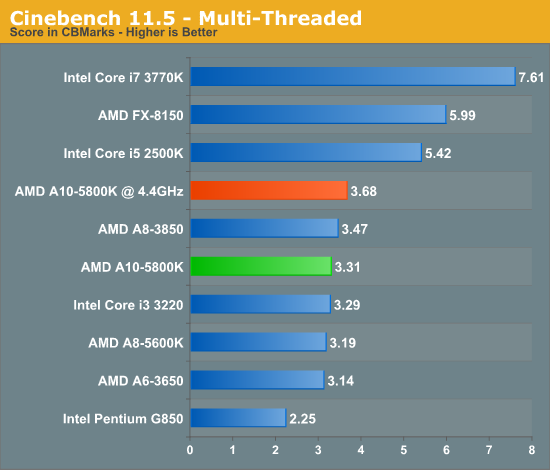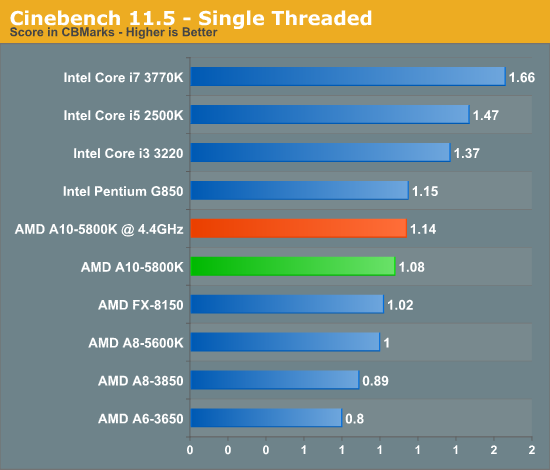AMD A10-5800K & A8-5600K Review: Trinity on the Desktop, Part 2
by Anand Lal Shimpi on October 2, 2012 1:45 AM ESTOverclocking
With Sandy Bridge Intel killed budget overclocking by completely clock locking all CPUs without turbo boost enabled. While you used to be able to buy an entry level CPU and overclock it quite nicely, Intel moved all overclocking to its higher priced parts. As a gift to the overclocking community, Intel ramped up the presence of its fully unlocked K-series parts. Anything with a K at the end shipped with a fully unlocked clock multiplier, at a small price premium. Given that Intel hadn't shipped unlocked CPUs since the days of the original Pentium, this was a welcome move on its part. What would really be nice is the addition of some lower priced K SKUs, unfortunatley we won't get that unless there's significant competitive pressure from AMD.
Trinity doesn't have what it takes to really force Intel into doing such a thing, but that doesn't mean AMD won't try. The Trinity lineup includes AMD's own K-series SKUs that, like their Intel counterparts, ship fully unlocked. From $67 all the way up to $122, AMD is offering unlocked Trinity APUs. The value of these parts really depends on just how overclockable Trinity is to begin with. The Bulldozer/Piledriver architecture is designed to push frequency, however AMD is already shipping these things at very close to 4GHz to begin with. Take AMD's turbo frequencies into account and you're already at 4.2GHz with the A10-5800K. How much additional headroom is there?

With a stock cooler and not a ton of additional voltage, it looks like there's another 5 - 15% depending on whether you're comparing base clocks or max turbo clocks. With an extra 0.125V (above the 1.45V standard core voltage setting) I was able to hit 4.4GHz on the A10-5800K. I could boot into Windows at 4.5GHz however the system wasn't stable. Although I could post at 4.6GHz, Windows was highly unstable at that frequency. With more exotic cooling I do believe I could probably make 4.5 work on the A10-5800K.

The extra frequency isn't enough to erase the single threaded performance gap between the A10 and Intel's Core i3 3220 however:

The only way AMD is going to close this gap is through a serious focus on improving single threaded performance in future architectures.










178 Comments
View All Comments
CeriseCogburn - Friday, October 12, 2012 - link
AMD's engineers can't seem to figure out pci-e 3.0They released their 7000 series with pci-e 3.0 uncertified (while nVidia waited and did a proper and offical implementation), then a bunch of amd card people had trouble in boards, but since the "press" kept their yappers shut except for a few, it wasn't widespread knowledge, so amd fanboys ( and others) suffered with their crap non certified cards, unable to chase down the plaguing glitches properly.
rarson - Wednesday, October 3, 2012 - link
"So as of today, in general - it costs more to get an AMD."...unless you actually want decent gaming performance.
The problem for Intel is that the things that Trinity doesn't do well aren't much of an issue to the average consumer. The average consumer doesn't have a clue how threaded their workloads are, and won't notice any significant differences between the i3 and the A10 other than how much faster the graphics are.
If I were going to build an HTPC without discrete graphics, I'd be buying a Trinity. Intel doesn't make sense in that application (of course, I'd probably still go discrete, in which case Intel makes more sense).
CeriseCogburn - Friday, October 12, 2012 - link
That's great rarson, when amd is crap, it's ok because people need crap, and won't notice the crap they have.LOL
Someone may be full of crap.
g101 - Monday, October 22, 2012 - link
Yeah, you. You lifeless little shit. Find something better to do than comment on every anandtech article with senseless garbage that never contains a shred of evidence or fact.rarson - Wednesday, October 3, 2012 - link
"I think there is very little need for raw single-threaded performance increases in consumer-level "general computation" processors (e.g. few-core x86 processors)."Exactly. While AMD could stand to improve their single-threaded performance, the fact that Intel is so far ahead in that specific metric doesn't automatically mean that Trinity is "slow." It does other things quite well, including multi-threaded performance, which is obviously more of a concern at this point considering software is moving towards multi-threading anyway.
CeriseCogburn - Tuesday, October 9, 2012 - link
LOL - you are such a sad fanboyI hope amd showers you as fanboy of the month with their slow crap so you have to use it.
amd4evernever - Sunday, October 14, 2012 - link
http://www.tomshardware.com/reviews/a10-5800k-trin...choke on that.... no matter how you troll the amd solution in the ends beats the core i3 both in price and in gaming read the full article at tomshardware.. you lunatic.
g101 - Monday, October 22, 2012 - link
You stupid little bitch, you comment on EVERY article with pro nvidia/intel comments and every single one is absolute rubbish.What I really want to know is: how the fuck can you have nothing better to do, yet still be so ignorant?
rarson - Wednesday, October 3, 2012 - link
"We need this for some real progression to be made in desktop CPU's and also drive prices down at the high end."Why? Is an i7 not fast enough for you? Are you being bogged down by your uber-user workload?
The vast majority of people buy processors that are cheaper than the A10 here. Sure, it'd be nice to see AMD compete at the high end again, but the high end doesn't drive the market; the high end is barely a blip on the radar.
Flunk - Tuesday, October 2, 2012 - link
Exactly, why buy the kids a new A10 when I can just give them my old Q6600? AMD really needs to make a better case for themselves than this.